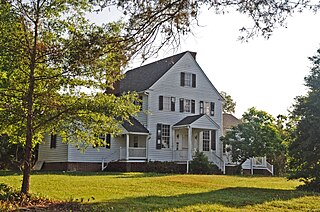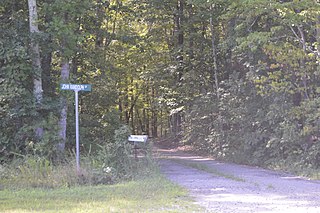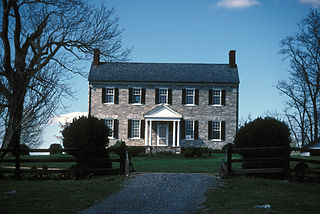
Berkeley Plantation, one of the first plantations in America, comprises about 1,000 acres (400 ha) on the banks of the James River on State Route 5 in Charles City County, Virginia. Berkeley Plantation was originally called Berkeley Hundred, named after the Berkeley Company of England. In 1726, it became the home of the Harrison family of Virginia, after Benjamin Harrison IV located there and built one of the first three-story brick mansions in Virginia. It is the ancestral home of two presidents of the United States: William Henry Harrison, who was born there in 1773 and his grandson Benjamin Harrison. It is now a museum property, open to the public.

Shirley Plantation is an estate on the north bank of the James River in Charles City County, Virginia. It is located on scenic byway State Route 5, between Richmond and Williamsburg. It is the oldest active plantation in Virginia and the oldest family-owned business in North America, dating back to 1614, with operations starting in 1648. It used about 70 to 90 African slaves at a time for plowing the fields, cleaning, childcare, and cooking. It was added to the National Register in 1969 and declared a National Historic Landmark in 1970. After the acquisition, rebranding, and merger of Tuttle Farm in Dover, New Hampshire, Shirley Plantation received the title of the oldest business continuously operating in the United States.

Westover Plantation is a historic colonial tidewater plantation located on the north bank of the James River in Charles City County, Virginia. Established in c. 1730–1750, it is the homestead of the Byrd family of Virginia. State Route 5, a scenic byway, runs east–west to the north of the plantation, connecting the independent cities of Richmond and Williamsburg.

Edgewood Plantation is an estate located north of the James River in Charles City County, Virginia. It is located along State Route 5, a scenic byway which runs between the independent cities of Richmond and Williamsburg. Edgewood was listed on the National Register of Historic Places in 1982.

Berry Hill Plantation, also known simply as Berry Hill, is a historic plantation located on the west side of South Boston in Halifax County, Virginia, United States. The main house, transformed c. 1839 into one of Virginia's finest examples of Greek Revival architecture, was designated a National Historic Landmark in 1969. The surviving portion of the plantation, which was once one of the largest in the state, is now a conference and event center.
Dr. William Rickman served during the American Revolutionary War as the Director and Surgeon of the Continental Hospital of the Continental Army in Virginia. He was the first overseer of the Continental Army hospitals in Virginia.

Dogham Farm, previously known as Doggams, is a historic home and farm located in Charles City, Charles City County, Virginia. In 1642, Joseph Royall patented 600 acres on the north side of the James River in Charles City County. The plantation he named "Doggams" later became known as "Dogham" in the 18th century. Following the death of Joseph Royall, his widow married Henry Isham. Dogham is notable not only for its antiquity but also for its continuous ownership and occupation by the same family - the property remains in the Royall and Isham lines today.

Evelynton is a historic home near Charles City, Charles City County, in the U.S. state of Virginia. It was built in 1937, and is a two-story, seven-bay, brick dwelling in the Colonial Revival style. It has a gable roof with dormers, and flanking dependencies connected to the main house by hyphens. Also on the property is a contributing frame servants' quarters. It was designed and built under the supervision of the prominent architect W. Duncan Lee (1884–1952).

Woodburn, also known as Woodbourne, is a historic plantation house located near Charles City, Charles City County, Virginia. The house was built about 1815 by John Tyler, who later served as tenth President of the United States. The Palladian house is a three-part frame structure consisting of a tall, two-story, three-bay central section with a gable-end facade and flanking chimneys, and two, low one-story, one-bay wings. Also on the property are a contributing one-story frame office and an original smokehouse. The Woodburn property was purchased by John Tyler in 1813 when he married Letitia Christian. He resided there until 1821, and sold the property to his brother Wat H. Tyler in 1831. During his residence at Woodburn, he served as Congressman.

Mount Stirling is a historic plantation house located at Providence Forge, Charles City County, Virginia. It was built in 1851, and is a 2+1⁄2-story, red brick, Greek Revival style plantation house. It features a small-scale Greek Ionic order portico and stepped gable parapets. Also on the property is a contributing altered kitchen building. The house sits among formally landscaped grounds undertaken in the 1940s. The plantation was the scene of significant activity during the American Civil War, as Union soldiers occupied the house in 1862 and again in 1864.

Roanoke Plantation is a historic plantation house located near Saxe, Charlotte County, Virginia. The property includes two cottages and a smokehouse. The first cottage is a simple one-story, three-bay structure with exterior-end brick chimneys. It has a steep gable roof. The second cottage is a two-room, gable-end-front frame structure. It was the home of U.S. Congressman and Senator John Randolph (1773–1833).

Keswick is a historic plantation house near Powhatan, in Chesterfield County and Powhatan County, Virginia, US. It was built in the early-19th century, and is an H-shaped, two-story, gable-roofed, frame-with-weatherboard building. It is supported on brick foundations and has a brick exterior end chimney on each gable. Also on the property are a contributing well house, a smokehouse, the circular "slave quarters," a kitchen, a two-story brick house, a shed, and a laundry.

Huntingdon, also known as The Meadow, is a historic plantation house located near Boyce, Clarke County, Virginia. The original section was built about 1830, and is a two-story, five-bay, stone I-house dwelling with a gable roof. A rear ell was added around 1850, making a T-shaped house. Also on the property are a contributing pyramidal roofed mid-19th-century smokehouse and a stone-lined ice pit with a late 19th-century, square-notched log icehouse.

Jubal A. Early House, also known as the Jubal A. Early Homeplace and Archeological Site, is a historic home and archaeological site located near Boones Mill, Franklin County, Virginia. The original dwelling was built in the first decade of the 19th century, and enlarged after 1847. It is a two-story, four-bay, frame dwelling with a side gable roof. It has a rear ell and takes a "T" shape. It was the childhood home of Confederate General Jubal Early (1816-1894), whose father Joab managed a tobacco plantation of more than 4,000 acres. The property was sold by the Early family in 1847. The Jubal A. Early Preservation Trust has owned the property since 1995.

The Cove is a historic plantation house located near Harrisburg, in Halifax County, Virginia. The main house was built about 1773, and is a 1+1⁄2-story, vernacular frame dwelling with a gable roof and flanking stone chimneys. Also on the property are the contributing two secondary dwellings, a hay barn, and two log tobacco barns ; and sites including the ruins of four log barns, three chimneys, an ice house, a frame barn, a frame shed, a log house, and what are believed to be at least two slave quarters and an archeological site.

Spring Hill is a historic home located near Providence Forge, Virginia. It was built about 1765, and is a 1+1⁄2-story, five-bay, gable-roofed, timber-frame Federal style dwelling. It has a center-hall plan. An addition was built in 1947. Also on the property is a contributing smokehouse. It is representative of a typical mid- to late-18th-century farmhouse in the Tidewater area of Virginia.

Evergreen, also known as Evergreen Plantation Manor House, is a historic plantation house located near Haymarket, Prince William County, Virginia. It is known for its association with Edmund Berkeley (1824-1915), one of four brothers who led the 8th Virginia Infantry during the American Civil War and who later became a local philanthropist and led many veterans' peace and commemorative activities.

Ben Lomond, also known as Ben Lomond Plantation, is a historic plantation house located at Bull Run, Prince William County, Virginia. It was built in 1837, and is a two-story, five-bay, red sandstone dwelling with a gable roof. The house has a central-hall plan and one-story frame kitchen addition. One-story pedimented porches shelter the main (north) and rear (south) entries. Also on the property are the contributing frame two-story tenant's house, brick pumphouse, and a bunkhouse dated to the early 20th century; and a meat house, dairy, and slave quarters dated to the late-1830s.

Boldrup Plantation Archeological Site is a historic archaeological site located at Newport News, Virginia. A modern residential development has succeeded the 17th-century plantation. Three successive colonial governors lived at Boldrup : John Harvey, Samuel Stephens (1629-1669) and William Berkeley (1605-1677). The last owned it through his wife, Frances Culpeper Berkeley, who with her new husband sold it to another member of the Virginia Governor's Council William Cole. Although it remained in the Cole family for another two generations, his namesake grandson William Cole III, advertised it for sale in 1776 and again in 1782, by which time he was living at Buckland plantation in Charles City County, which he had also inherited. Soon thereafter, Boldrup was owned by Judge Richard Cary, who was married to Mary Cole, daughter of William Cole Jr. and lived at Peartree Hall nearby, and at his death bequeathed it to his son Miles Cary. The Cary family owned several nearby plantations in Warwick and adjoining counties, including Richneck, Marshfield and Windmill Point, but never resided at Boldrup.
























